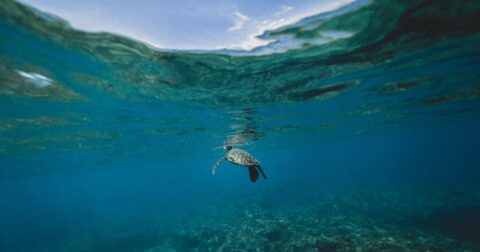News
Meat Consumption Grows in US and Asia, While Europe is on the Decline
Climate•3 min read
Perspective
Humans are the major driver of biodiversity collapse in the oceans. Stronger radar, bigger nets, and faster ships have allowed fishing vessels to plunder the oceans with remarkable efficiency.

Perspective • Climate • Oceans

Words by Nicholas Carter
The oceans are under attack. In recent years, the commercial fishing industry has taken control, threatening the future of these fragile, carbon-sequestering ecosystems and the aquatic animals who call them home.
According to the Intergovernmental Platform on Biodiversity and Ecosystem Services, 55 percent of the ocean is covered by industrial fishing, and 66 percent of the global marine environment has been altered by human actions. Technological prowess in fishing is the major driver of biodiversity collapse in the oceans. Stronger radar, bigger nets, and faster ships have allowed fishing vessels to plunder the oceans with remarkable efficiency.
Oceans absorb about 30 percent of the CO2 emitted every year, more so in protected areas with kelp forests and higher biodiversity. In fact, undisturbed natural ecosystems contain more carbon than their agricultural counterparts. This is true as well with undisturbed ocean ecosystems, which means that the more we fish, the more lives we threaten, and the less carbon we draw out of the atmosphere.
Biodiverse ocean ecosystems help store carbon, saving us billions of dollars in climate change damages. The Global Ocean Commission report calculated that ocean organisms living in the high seas—60 percent of global ocean waters, located outside the economic zones of specific nations—absorb 1.5 billion metric tons of carbon from the atmosphere each year. Given the dollar figure associated with that carbon sequestration, they concluded it would make more economic sense to ban commercial fishing altogether.
In 1950, 20 million tonnes of fish were harvested from the oceans. As of 2018, 179 million tonnes were caught. That’s almost 100,000 fish per second. Fishing is the single largest form of ocean ecosystem destruction. Currently, 33 percent of the oceans are fished beyond sustainable levels, and 60 percent are fished at their maximum. But it’s not just the extraction of fish, it’s the plastic fishing gear that’s abandoned, lost, or discarded that represents nearly 20 percent of all plastic in the oceans.
The insidious subsidizing of the seafood industry is one of the major reasons for ocean destruction. According to a 2009 estimate, the industry receives nearly $39 billion in handouts per year. Despite this funding, corporations marginalize their workers and force them into debt slavery. There is a human rights crisis happening on the high seas. Fleets from Spain, China, South Korea, Taiwan, and other countries are operating with virtual impunity. These countries are at the core of an illicit trade that spans 60 percent of the world’s oceans and generates an estimated $160 billion in annual sales.
One has to wonder then, is it possible to sustainably source seafood or at least trust certifications like the Marine Stewardship Council (MSC), the most popular sustainability certification that many consumers look for in grocery chains. However, surprising to some, they’re rife with greenwashing. At this stage of the environmental crisis, we’re past the point of having the luxury to make small incremental changes, like opting for certified sustainable seafood.
Of course, MSC-approved fisheries are better than your typical unregulated trawling operations. But consider that MSC has awarded blue eco-labels of certified sustainability to over 130 fisheries around the world. The fisheries pay over $100,000 to get privatized third-party audits. These audits do not come from environmental assessors, but from companies who coach fisheries on how to get approved. All fisheries seriously seeking this MSC certification since the 1990s have been approved, with their fair share of controversy.
At a time when consumers are increasingly skeptical of the environmental impacts of consuming sea animals, the motives of these so-called stewards of the ocean comes into question. MSC has had success stopping some overfishing activities, but going into 2021, widespread radical action is needed to protect the oceans. Doing slightly less harm won’t cut it.
Reducing or banning commercial fishing, at least in rich countries, should be the first consideration, with marine protected areas (MPAs) as a clear governmental solution. Some refer to these protected areas as conservationists’ silver bullet. Other studies even go as far as stating that if we were to increase the amount of MPAs, say by just 5 percent, we could improve future catch by at least 20 percent. This is akin to saying if we protect certain areas from fossil fuel extraction, that it’ll increase what can be taken in surrounding areas. It’s time to move past this mindset of extraction and exploitation.
Unsurprisingly, a meta-analysis of scientific studies on the topic shows that the biomass of fish, on average, is 670 percent greater within fully protected areas. Right now, 8 percent of the ocean is protected, and only 2.6 percent of those MPAs are considered strongly protected and fully off-limits to fishing.
Marine protected areas have shown to be an effective means of safeguarding vulnerable species and ecosystems, conserving biodiversity, re-establishing ecosystem integrity, instituting clear guidelines, and sheltering the feeding and breeding areas of marine species. They also play a role in increasing the carbon storage of the oceans, to buy us much needed time in our need to transition away from fossil fuels.
Consider an example in British Columbia, Canada, where sea otters have been successfully reintroduced to the ecosystem. Sea otters eat sea urchins, who eat kelp. Naturally, if there aren’t sea otters, sea urchins eat too much kelp, which is a vital component in ocean sequestration. Since the rebound of sea otters, the kelp forests have grown twenty-fold and now sequester about 10 percent of BC’s carbon emissions.
Some fishermen in the area are not happy with this because otters eat a quarter of their body weight every day, including a supply of clam and crabs that they claim ownership of. This brings up another pressing issue: biodiversity of life will frequently be threatened by our addiction to eating and farming animals.
When protecting large areas of the ocean, the international waters just outside the zones are frequent targets of large fleets of trawlers. Many of the trawlers outside of MPAs catch some of the 100 million sharks that are killed each year for food. Not only will this result in the extinction of many species of sharks, but removing a predator from a healthy ecosystem creates a major ecosystem imbalance.
To address this illegal and unregulated fishing, compromises are being made, like the Agreement on Port State Measures (PSMA). Paul Rose, the Expedition Leader with National Geographic’s Pristine Seas, hopes agreements like this, along with new satellites and artificial intelligence that can track vessels that may turn off their tracking equipment, could end illegal unreported fishing.
Since its inception, Rose’s team has inspired the creation of 23 marine reserves. In November, the group announced that they had secured the largest no-catch marine protected zone in the Atlantic Ocean. Tristan da Cunha, a British territory island in between South America and South Africa, and the surrounding ocean equal to the size of Texas will be protected for millions of seabirds, penguins, sharks, and whales. The marine sanctuary will span 265,347 square miles, almost three times larger than the United Kingdom. Ninety percent of the waters around the island chain will also become a “no-take zone,” where fishing, mining, and other extractive activities will be banned.
National Geographic Explorer-in-Residence Enric Sala, who founded Pristine Seas, concluded that “we have 10 years to protect 30 percent of the ocean if we want to stop the extinction of species.” Sala and his team are well on their way, protecting nearly 6 million square kilometers of oceans so far.